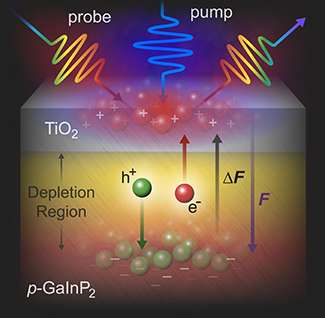Photoelectrodes revealed

To turn intermittent solar energy into transportable chemical fuels, scientists are investigating a key junction inside designer photoelectrochemical cells. The junction forms between two materials: the layer that absorbs sunlight and releases electrons and the contacting layer that uses the electrons to produce fuel. The connections are difficult to probe. Scientists at the National Renewable Energy Laboratory (NREL) devised an ultrafast probe that measures electron transfer rates at these interfaces. Using the probe, they discovered that the junction promotes the release of electrons and suppresses unwanted reactions.
The next generation of materials for solar-driven fuel production, by splitting water into oxygen and hydrogen fuel, involves a thin titanium dioxide layer on a semiconductor light absorber such as the gallium indium phosphide system. Peering into these interfaces with new spectroscopic tools can provide critical insight to allow further improvements in efficiency and stability.
Photoelectrochemical cells use semiconductor photoelectrodes to convert energy directly from sunlight into storable chemical fuels. Semiconductor junctions are critical components of these cells, and the carrier dynamics of this system—charge separation and recombination across such junctions—represent a key factor in determining the cell's performance. However, probing charge flow at the electrode interfaces in these cells has proven difficult. Researchers at NREL have developed such a probe for these carrier dynamics by taking advantage of the charge separation that occurs when absorption of light produces mobile charges near a junction. This method is based upon the equilibration of electrochemical potential across a semiconductor junction. The electrochemical potential creates internal electric fields for separating the negative and positive photo-generated charge carriers involved in the fuel-producing reaction.
Researchers at NREL introduce a novel spectroscopic technique to monitor the electric fields involved with the interfacial charge-transfer. The fields induced across these junctions by charge flow create an oscillatory modulation of light reflectance at the interface of interest, allowing for the detection of the fields experimentally through the Franz-Keldysh effect. This provides a specific probe of the magnitude and time scale of charge flow at these interfaces. Researchers can use this technique to probe the working principles of the fuel-producing reactions at the GaInP2/TiO2 interface, which has gained significant interest in the photoelectrochemical community.
More information: O. Khaselev. A Monolithic Photovoltaic-Photoelectrochemical Device for Hydrogen Production via Water Splitting, Science (1998). DOI: 10.1126/science.280.5362.425
Y. Yang et al. Semiconductor interfacial carrier dynamics via photoinduced electric fields, Science (2015). DOI: 10.1126/science.aad3459
Journal information: Science
Provided by US Department of Energy


















